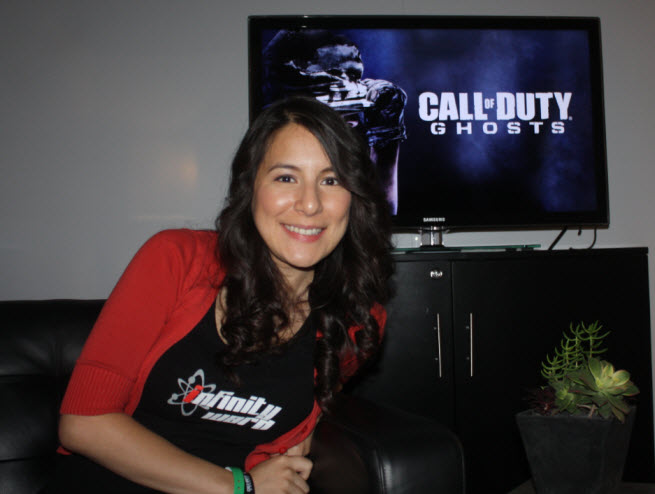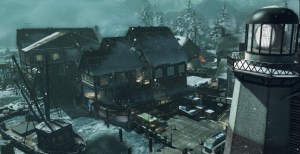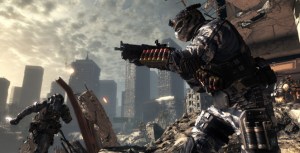GamesBeat: It seems like there are different philosophies for multiplayer between you guys and Treyarch, with Black Ops II. Is there anything obvious you’d point out? I remember the support streaks were very big with them. It felt like even if you weren’t the best shooter, you could still contribute to the team effort by being a support player.
Palacios: Yeah, in Black Ops II they had score streaks. We have different kill streak packages. We have assault, where you can gain kill streaks by how many deaths you rack up. With support, it’s just dependent on how you support the team. If you capture points or get assists, that all counts toward your support kill streaks. That won’t reset when you die, which is the key. I think a lot of new people will love using that.
GamesBeat: If I were playing in Black Ops II, I’d get a light machine gun, camp out in spot with a long field of fire, and then protect my back with Bouncing Bettys or shock charges. That was a good way to stay alive for a longer period than I normally would running around. Can you think of an equivalent play style in this game?
Palacios: I guess it all depends on what you prefer in terms of kill streaks. A lot of the perks that we included will help if you want to play stealthy. One we introduced today is called Takedown. When you kill somebody on the other team, Takedown makes sure that their teammates can’t see where they died. That’s really significant. Right now, it has an icon showing where your teammates die, so you can see where the action is happening. Using a perk like that helps you out.
We also talked about the support kill streaks. Someone who doesn’t want their kill streak gauge reset when they die would want to use that. I think a lot of experts will want to use that as well, though, because there are some really cool kill streaks in that. We talked about the helo sniper today. A helicopter picks you up and flies you around and you can control where you go on the map while you snipe people.
GamesBeat: Was there anything you decided to move away from or leave behind because gamers thought they were too easy or too hard?
Palacios: Death streaks were one thing we left behind. In Modern Warfare 3, if you died consecutively for a specific amount of time, you’d earn an incentive. Juiced gave you the ability to run faster after you were spawned if you died three or four times. Things like that. We got rid of those. Based on all our feedback, the fans didn’t seem to like it.
GamesBeat: When you’re triggering the dynamic events, does that happen because you’re very skillful, or can you also pull it off just because you know where to be and get lucky?
Palacios: It all depends on the map. Each one has a unique dynamic event attached to it. In Strike Zone today, you saw people running around and playing in a stadium. The way you unlock that event is by completing a field order. Field orders are briefcases that are dropped around a multiplayer match. When you pick one up, it gives you an objective – anything from getting a headshot to using a melee weapon. When you do that, you earn the kill streak that allows you to destroy Strike Zone, and it becomes a whole new map. The lanes and the set lines change. But it depends on the map you’re on.
GamesBeat: I was on a map where you could shoot the legs out from under a building that would collapse on top of people.
Palacios: Oh, that was Octane. On that one, you can interact with parts of the buildings to blow them up or take down that gas station roof. I think we even added red icons on walls you can interact with to do something.
GamesBeat: I noticed on the Domination map that around the B flag in the cave, everybody was just gravitating toward that. You could just throw a grenade down that way, and everybody’s there. Why would you do a design like that?
Palacios: On Whiteout, yeah, that’s an intense spot. The multiplayer designers really take a look at how players move on a particular map. We playtest almost every day at the office, and we pay close attention to how people move. But creating a spot like B on Whiteout leaves A and C up for grabs. Some people may think everyone’s running to B, but the smart player will say, “Well, I guess A and C are open. I’ll go that way.”
GamesBeat: The Cranked mode seems like it’s pretty newbie-friendly. You’re just shooting as much as possible, and everybody’s motivated to do that. The Search and Rescue, you could die once and die forever there. That doesn’t sound like it’s quite so friendly.
Palacios: Search and Rescue is interesting, because we wanted to take Search and Destroy – a familiar mode – and give it a new take. In Search and Destroy, once you died, you were out of the match until the next round. With Search and Rescue, when you die, your teammates can pick up your tag and save you and bring you back into the game. Or, if the enemy gets to it first, you’re out of the match.
That’s an interesting mode. When we were playing at the studio, I noticed that people had different tactics. Before, they would play very slow in Search and Destroy. You’d be very careful about going out in the open. But now, with Search and Rescue, I feel more confident running out with a teammate. If I die, there’s a chance they can revive me.
VentureBeat's mission is to be a digital town square for technical decision-makers to gain knowledge about transformative enterprise technology and transact. Learn More




